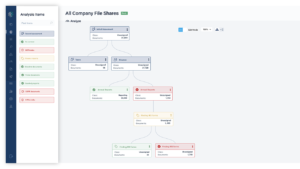The Classify360 Approach: Classify
Analyze enterprise data according to shared business qualities or characteristics. Uncover data strengths and expose weaknesses, empowering complete data management.
Analyze enterprise data according to shared business qualities or characteristics. Uncover data strengths and expose weaknesses, empowering complete data management.
The Classify360 information engine is comprised of precise machine learning and analysis models which accurately and quickly classifies and categorizes data according to business policies and governing regulations. Classified data empowers organizations to act upon data for retention, compliance, migration, or cleanup.
Get started with pre-built models that quickly segments your dataset by like characteristics and qualities. These models provide a visual data representation to help prioritize and define your data management approach.
Further evaluate data segmentations according to unique business policies and governing data regulations by layering tailored analysis models. Assign data to appropriate classes to enable proper protection, optimal storage, and maximum business value.
The use of algorithms and statistical models allows for confident, hands-off data analysis. Classify360 continuously learns and adapts to your business requirements, providing intelligent and effortless ongoing data management.
Standard models are derived from common enterprise logic such as retention, risk, PII, etc. and prevalent privacy and industry regulations like GDPR, CCPA, HIPAA, and NYDFS for quick data analysis. Create your own business-specific workflows to support your organization’s unique needs.
Organize and sort stored data into internal, public, proprietary, and confidential buckets. Group similar data together based upon common qualities and parameters for ease of review.
Use a standard model to find similar items within a data set, or further customize the model by providing training documents and human feedback. The more you use Classify360, the more accurate your results are.
The Classify360 is driven by the information engine, a series of components that powers supervised machine learning, duplicates analyses modeling, and analysis trees.
Supervised machine learning empowers users to classify data, maintain regulatory compliance, find cost-savings opportunities, and fulfill external audit requirements.
The duplicates analysis model reviews data in a repository to identify duplicates and their master copies based on age or location from any source in the repository. Files without duplicates are included too, so all data is considered equally.

Trying to build one classification model to cover every eventuality is near impossible!
To account for this challenge, analysis trees provide a visual representation of the classification process, allowing users to layer or remove rules and view the results in real time across petabytes of data. As results unfold, users can tag files with a class, such as “risk-sensitive data,” to classify them. Models are then applied to newly created data on an ongoing basis, ensuring all data within an organization is held to the same classification standards.
The foundation of a strong data management strategy is to segment the data that strengthens your business from the data that weakens it.
STRENGTHENS
WEAKENS
What is data classification?
Data classification is the process of analyzing structured or unstructured data and organizing it into categories based on file type, contents, and other business rules or priorities.
What is sensitive data analysis?
Sensitive data analysis is a model that determines which data is risky for your organization on a content level. The level of “risk” is relative to the parameters your organization determines are relevant to its business, industry, and regulatory best practices.
What is machine learning?
Machine learning (part of artificial intelligence) is a field of inquiry devoted to understanding and building methods that ‘learn’, that is, methods that leverage data to improve performance on some set of tasks. Your favorite media streaming apps use supervised machine learning to let you influence your likes and dislikes; they learn your preferences and adjust their suggestions accordingly. Similarly, Classify360 allows users to guide classification parameters and learns from those corrections. The more data users classify, the smarter Classify360 becomes.
How is dark data impacted by classification?
Dark data is the information assets organizations collect, process, and store during regular business activities, but generally fail to use for other purposes. Holding onto unneeded data increases the risk associated with a data breach and robs organizations of valuable time and monetary budget needed to maintain this irrelevant, risky data. Through the classification process, dark data is brought to the forefront; decision makers can effectively delete or securely store it, reducing risk and increasing organizational efficiency.
Can data be classified based upon context?
You can classify data based on any terms your business considers a priority. Context is a popular way to classify data because it allows you to identify specific elements of documents such as social security numbers, credit card numbers, other Personal Identifiable Information (PII), and other content-level items.
How does data classification drive business goals?
Data classification identifies stale and sensitive risk data, enabling you to better protect sensitive data or securely dispose of stale data. Data classification provides clear insight into what data your organization has collected over time, reducing the risk and impact of a data breach and ensuring ongoing compliance. Security and risk platforms produce better output when classification is the first step in the data management process, as they ingest accurate, up-to-date data that is properly tagging and classified.
Find the product that suits your business
Get started with a 29-minute call with our team
Get free insights into your dark, unstructured data in one week.